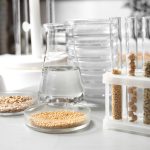SGS Crop Science News: September 2021
In this edition of SGS Crop Science Canada News:
- Seed Testing to determine Fit for Use and Certification
- Corn Silage, It’s GO TIME
- Greenhouse resources to Promote Plant Growth
SEED TESTING TO DETERMINE FIT FOR USE AND CERTIFICATION.
Seed to full-fill large scale grain production, reclamation, and turf grass export is undergoing extensive quality testing. In the last few months our 2 seed laboratories have already tested new crop of fescue, timothy, clover, peas, lentils and cereals. The top considerations when submitting your samples are:
- Representative Sample Creation: Build a homogeneous sample, representing the entire seed lot. Uniformity is key!
- Harvest Package Selection: At SGS, we have built Harvest Packages by crop, for ease of submission and savings! Learn more at www.cropscience.sgs.ca.
- Certification: Certified seed sale and export requires careful planning and execution. Both our labs are approved for Canada Grade Table testing, including germination, physical purity and true loose smut. Exporting to the US or EU? Let’s partner for ISTA Certificates, EU Grade Reports and APHIS documentation!
What should be considered when evaluating your quality data? The Report of Analysis will outline comprehensive data points. Both growing conditions and harvest weather greatly impact seed quality. As an example, hot, dry conditions during combining may contribute to elevated abnormal seedlings in pulses.
CORN SILAGE, IT’S GO TIME
In many parts of Canada forage harvesters are starting to roll through the fields. SGS is ready to help with the nutritional testing of your silages. We offer over 15 different test packages, and we are certain there is one to suit your dairy or beef cattle needs, plus your budget. The most common dairy package is Milk 2006. Also, toxin screens have been critical over numerous growing seasons to determine ration refusal and health risk, so do consider supplementing these individual tests to your package. Feeding costs will be higher this fall and winter. Building nutritionally balanced and least cost feeding programs starts with precise forage testing.
GREENHOUSE RESOURCES TO PROMOTE PLANT GROWTH
Optimal crop growth requires analyses to balance and monitor plant nutrition. With a few more months of greenhouse operation, focus on the contribution agricultural labs bring to the success of your business. SGS tests many greenhouse inputs and materials, to diagnose issues or amplify growth. The products we analyze are:
- Water – understand the raw water’s background mineral levels, pH, and EC (electrical conductivity)
- Solution – confirm the nutrient solution is mixed as expected and meets benchmarks before recirculating
- Media – ensure soil-less mixes have properly leached to remove salts and understand remaining nutrients
- Tissue – measure plant leaf tissue for deficiencies or imbalances
- Fertilizer – confirm the guaranteed analysis is as expected
- Microbiological – monitor bacterial levels, such as E. coli and total coliform, for food safety
- DNA Multi-Scan – detect fungal pathogens in water, media, and tissue, with over 70 species and sub-species reported, such as Pythium, Phytopthora, and Fusarium.
Sample collection, from determination of source and container type, to maximum shipping days (from sampling date) is precise.





